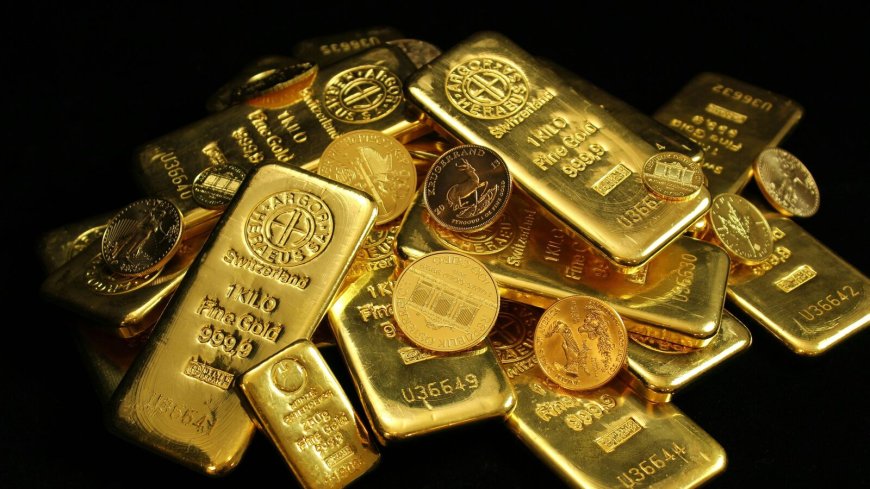Gold is Back Under Pressure After a Stunning Surge: What’s Driving the Dip?
Gold prices fall below $2,300 after a record-breaking rally. Discover what’s driving the decline, from Fed policy shifts to profit booking, and what it means for investors.

After a Strong Rally, Gold Faces Renewed Selling Pressure
Gold prices, which soared to record highs in May amid geopolitical concerns and dovish central bank signals, are once again feeling the heat as investors take profits and shift focus back to macroeconomic fundamentals. After breaching the $2,450 per ounce mark in early May, the yellow metal has since retreated below $2,300, raising questions about the sustainability of its recent bull run.
Key Drivers Behind the Dip
1. US Dollar Strengthening
The US dollar has regained strength in recent weeks, bolstered by resilient economic data and hawkish remarks from Federal Reserve officials. A stronger dollar makes gold more expensive for holders of other currencies, reducing its appeal as an alternative asset.
“Investors are recalibrating their expectations,” said Daniel Ghali, commodity strategist at TD Securities. “The Fed’s messaging has turned less dovish than markets had hoped, and that’s putting upward pressure on the dollar and yields, which is bearish for gold.”
2. Rising Treasury Yields
Benchmark US 10-year Treasury yields have climbed back above 4.4%, after dipping to around 4.2% during the gold rally. As real yields rise, the opportunity cost of holding non-yielding assets like gold increases, prompting a shift in portfolio allocation.
“Gold thrives when real yields are negative or falling,” noted Suki Cooper, precious metals analyst at Standard Chartered. “The current macro backdrop, where inflation expectations remain anchored and nominal yields are inching up, has reduced the urgency for gold exposure.”
3. Profit Booking and Technical Resistance
The stunning rise in gold prices earlier in 2025 drew in speculative interest, but also set the stage for a technical correction. Traders who entered during the rally are now booking profits, especially as prices failed to sustain momentum beyond $2,450.
“There’s clear evidence of long liquidation in futures markets,” observed Bart Melek, head of commodity strategy at TD Securities. “It’s a natural correction, not a sign of a bearish reversal, but we could see more downside if key support levels break.”
Market Sentiment: Still Bullish or Turning Bearish?
Despite the current weakness, sentiment in the gold market remains cautiously optimistic. The underlying macro drivers—central bank buying, global geopolitical tensions, and long-term inflation concerns—continue to provide a supportive backdrop.
China’s central bank, while slowing its pace of gold purchases in recent months, remains a key player in the market. Additionally, retail investment demand, especially from India and Europe, has shown resilience even at elevated prices.
“Gold remains a strategic asset in times of macro uncertainty,” said Ole Hansen, head of commodity strategy at Saxo Bank. “This dip may be more of a consolidation than a structural shift in trend.”
Impact of Fed Policy Outlook
All eyes are now on the US Federal Reserve, whose policy stance will be pivotal for gold’s next move. While earlier in the year markets were pricing in as many as three rate cuts in 2025, that outlook has become more uncertain.
The Fed’s June meeting and upcoming CPI data will be crucial in shaping interest rate expectations. If inflation proves stickier than anticipated, rate cuts may be delayed, further weighing on gold prices in the short term.
“We’re not in a rate-cutting cycle yet,” noted Joseph Brusuelas, chief economist at RSM US. “Markets have gotten ahead of themselves. That repricing is being reflected in gold, among other risk assets.”
Investor Outlook: Time to Buy the Dip?
With gold off its highs, investors are evaluating whether the current pullback offers a buying opportunity. Long-term bulls argue that the macro backdrop—rising debt levels, potential stagflation, and ongoing geopolitical risk—still makes gold a compelling hedge.
“Gold is a long-duration asset,” said Jeffrey Christian, managing partner at CPM Group. “Short-term dips should be expected after such a strong move. But over the next 12-24 months, we expect higher highs.”
However, short-term traders are advised to tread carefully, as volatility is likely to persist. Technical analysts point to $2,280 and $2,200 as key support levels to watch. A break below these could trigger further downside toward the $2,100 range.
Gold’s recent pullback marks a healthy correction after an exuberant rally, rather than a fundamental shift in trend. While rising yields and a stronger dollar are putting pressure on prices, long-term tailwinds such as central bank demand, inflation risks, and safe-haven appeal remain intact.
Investors should monitor upcoming economic data and Fed guidance for cues on whether gold’s dip presents a buying opportunity or the start of a deeper correction. For now, the yellow metal is consolidating—neither breaking down, nor breaking out.
What's Your Reaction?
 Like
0
Like
0
 Dislike
0
Dislike
0
 Love
0
Love
0
 Funny
0
Funny
0
 Angry
0
Angry
0
 Sad
0
Sad
0
 Wow
0
Wow
0













































































